Spring 2003 Banding Summary
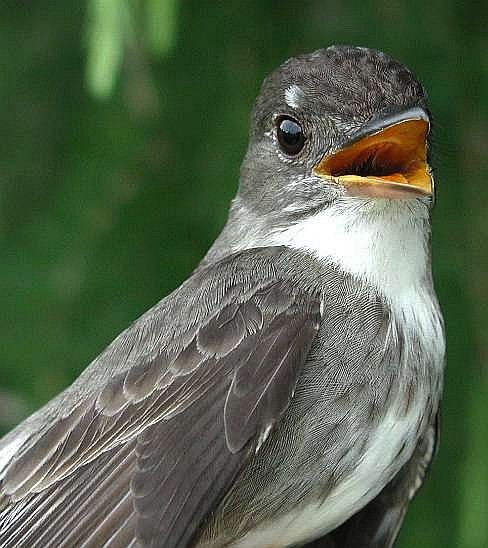

The bird-banding programat
Powdermill
Nature Reserve, a 2,000 acre field biological
station of Carnegie Museum of Natural History
located in the Laurel Highlands region of southwestern Pennsylvania, was
in operation on 74 out of a possible 93 days during the spring 2003 season
(March 1 through June 1). A nearly average 2,479
birds of 105
species was banded, with the busiest day being
145 birds of 38 species on May 15--this was the daily maximum for both
number of birds and number of species during spring 2003 (Figure
1). Although not as busy a season
as last spring (when 3,475 birds of 109 species were banded), this one
day total for number of birds and number of species banded exceeded the
highest daily totals recorded last spring (137 birds banded on 4/27/02
and 37 species banded on 5/15/02). The catch on this spring's
busiest day was dominated by wood warblers (16 species), including 27
Magnolia Warblers,
12
Common
Yellowthroats,
nine
American Redstarts,
and seven each
of Chestnut-sided and
Black-throated
Blue Warblers.
.
Figure 1. Daily banding totals and species counts for spring 2003 at Powdermill Nature Reserve. Smaller inset graph shows the relationship between daily banding totals and daily species counts.
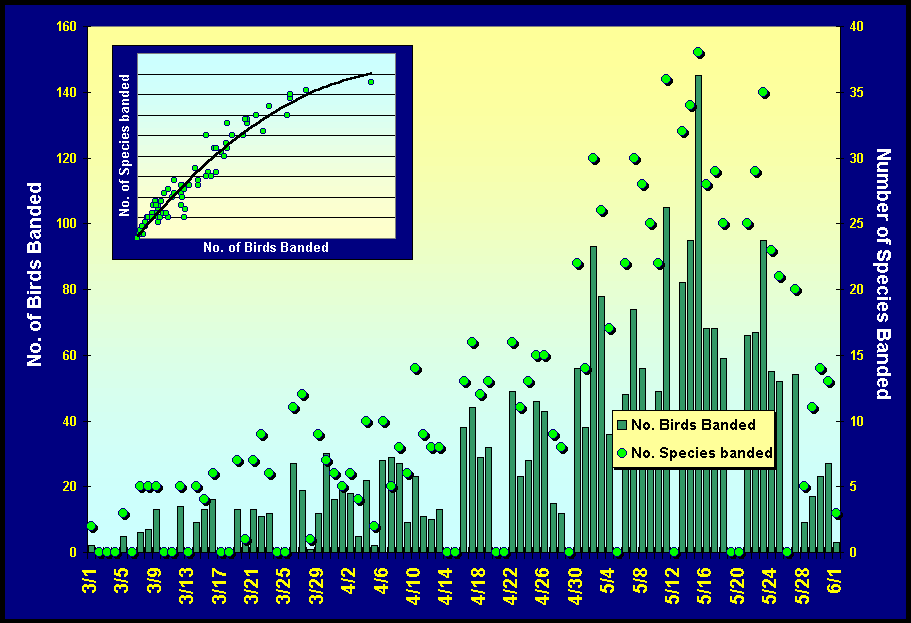
The timing of spring migrationacross
species is what produces the pattern of daily banding totals (both in terms
of number birds and number of species) like that shown in Figure
1 above. Figure
2 below is based on the cumulative spring
banding totals for more than 75 species over the last 40 years at Powdermill.
It shows interspecific differences in seasonal occurrence (ranging from
the entire spring season, i.e., March 1 through May 31, e.g., for American
Robin and American
Goldfinch, to little more than two weeks in
mid- to late May, e.g., for Bay-breasted
and Blackpoll warblers),
as well as patterns of seasonal abundance for each species (and for the
sexes within selected species). Because the abundance scale for each
species is different (and not shown), however, seasonal abundance among
species cannot be compared directly.
.
The graphs making up Figure
2 depict changes in relative abundance for
species across the spring season. In species for which all or most
birds can be sexed, the timing of migration of the sexes is shown separately
(males in blue; females in red); species with some or all birds of unknown
sex are shown in pale yellow. In all species, the area of the curves
(including for the sexes when they are distinguished) is proportional to
abundance for any given banding date. For example, in Ruby-crowned
Kinglet, the first three weeks of the species'
migration at Powdermill is entirely comprised of male birds, followed by
a week or more when the sexes occur in about equal numbers, and finally
by a two week period when virtually all of the RCKIs
banded are females. From Figure 2,
is is apparent that, overall, the species is most abundant at Powdermill
during the roughly ten-day period in late April when the sexes co-occur
in migration.
Figure 2
shows that the early part of the spring migration at the Powdermill banding
station (i.e., March through early April) is dominated by captures of winter
resident individuals of species like Blue
Jay and Black-capped
Chickadee and of no more than a dozen or so
early migrants, like Golden-crowned Kinglet,
Fox
and
Song sparrows,
and Dark-eyed Junco.
The middle portion of the spring season (i.e., the last 2-3 weeks of April)
brings the bulk of Ruby-crowned Kinglets
and other sparrows, blackbirds, and finches (e.g., Chipping,
Field,
White-throated,
and Swamp sparrows,
Brown-headed
Cowbird, and Purple
Finch), while the height of the migration
in mid-May (i.e., 10-20 May; see also
Figure
1) coincides with flights of the greatest
diversity of migrants, especially Neotropical migrants like Ruby-throated
Hummingbirds, vireos, thrushes, orioles, and
most wood warblers. The tail end of the migration (i.e, late May)
is dominated by several species of flycatchers and later migrating species
of thrushes and wood warblers. The end of May cutoff for the graphs
in Figure 2 clearly
cuts off the migration artificially for several of these species, some
of which are still migrating through Powdermill as late as mid-June.
.
Figure 2. Timing of spring migration of selected bird species at Powdermill Nature Reserve, based on cumulative daily banding totals from March through May, 1962-2002.


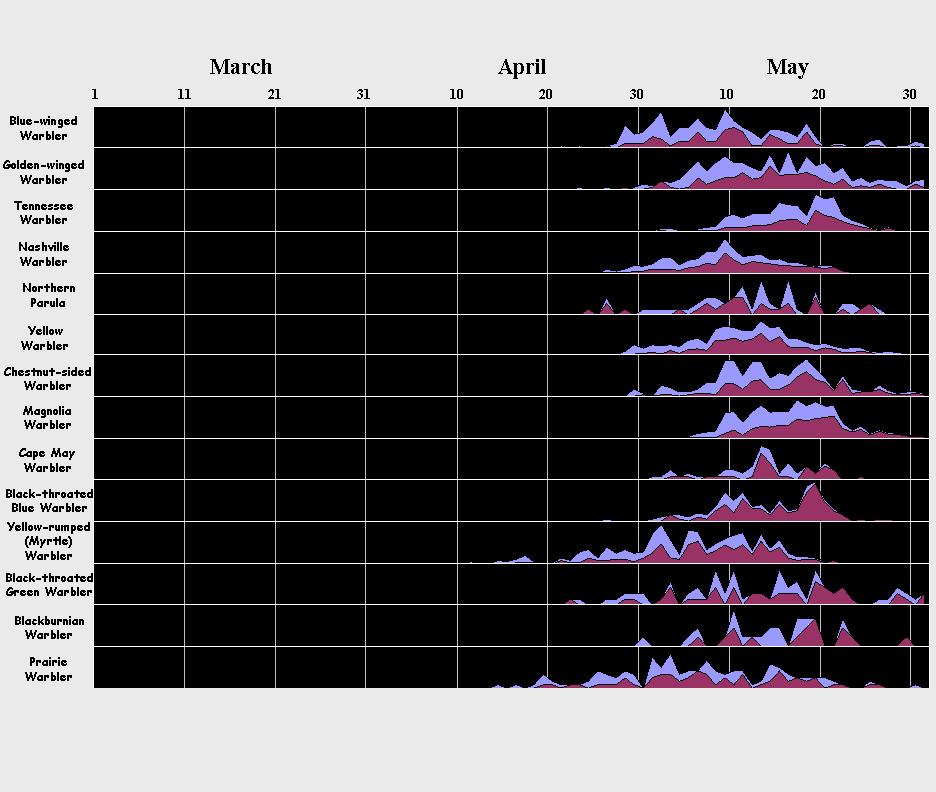
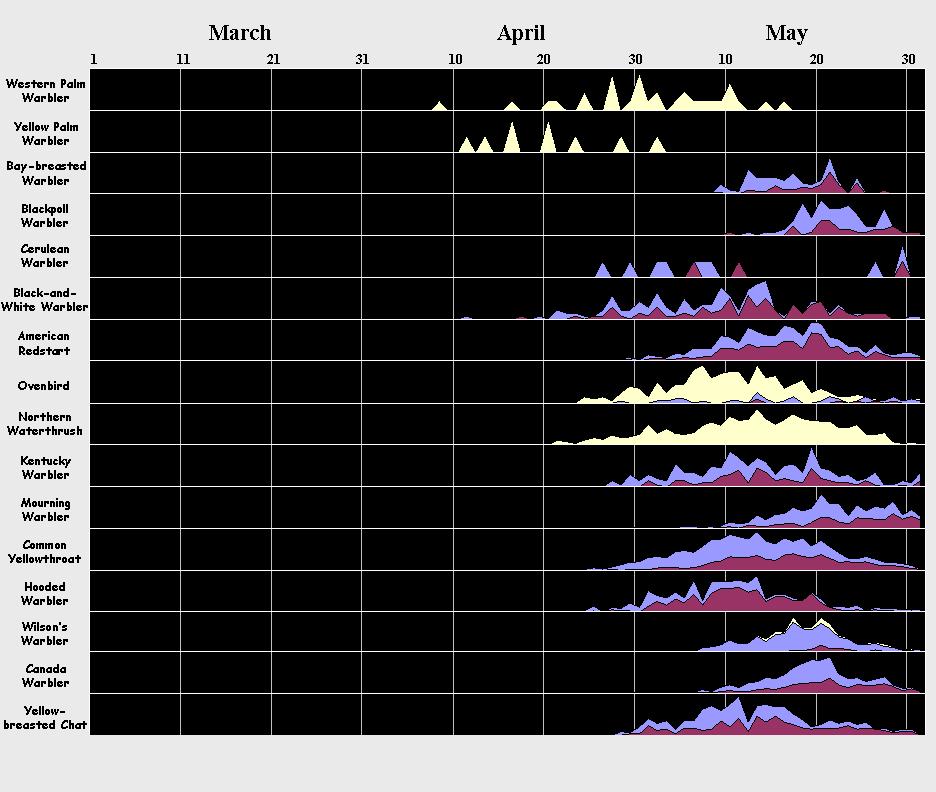
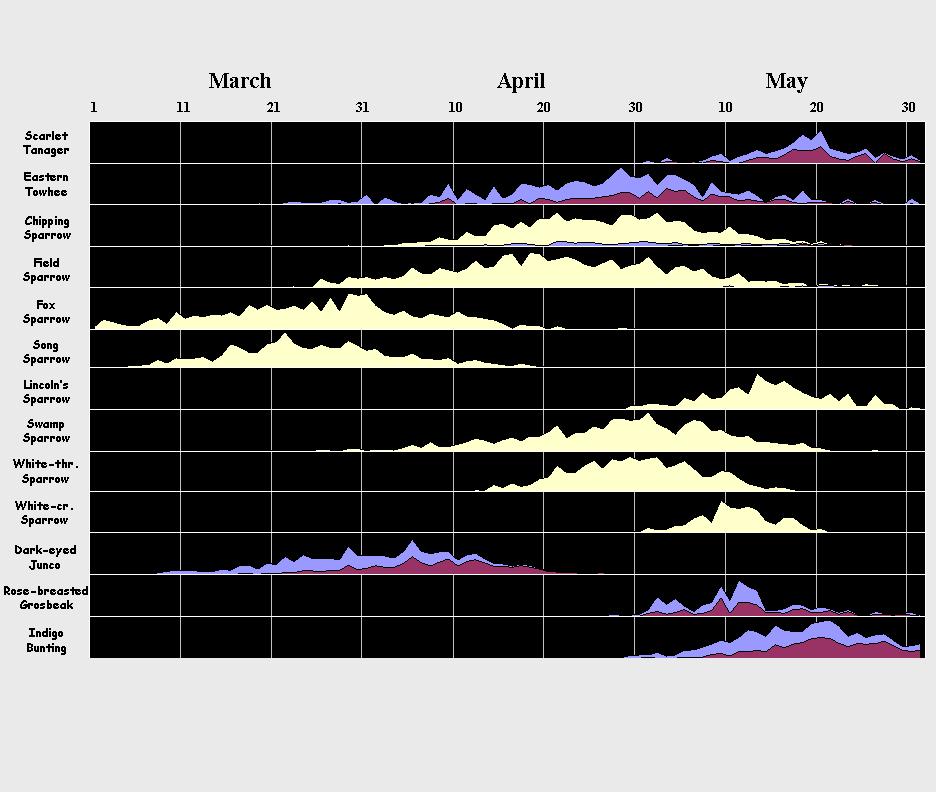
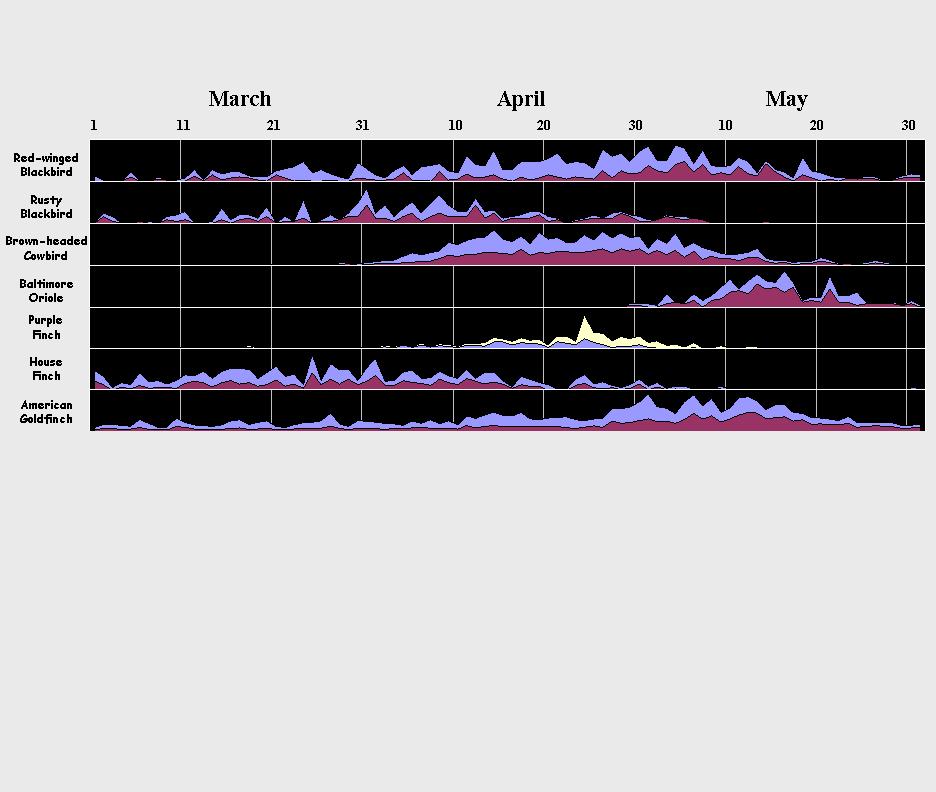
| Comparison with 40-yr. (1962-2002) average (S.D.=standard deviation) | ||||
| within 1 S.D. | >1 S.D. above | <1 S.D. below | ||
| SPECIES BANDED IN SPRING 2003 |
Totals |
(XX = ties or sets record high or low spring total) | ||
| ALL BIRDS | 2,479 | X | ||
| Magnolia Warbler | 156 | X | ||
| American Goldfinch | 145 | X | ||
| Dark-eyed Junco | 139 | X | ||
| Ruby-crowned Kinglet | 89 | X | ||
| Ruby-throated Hummingbird | 87 | X | ||
| Nashville Warbler | 82 | X | ||
| Cedar Waxwing | 81 | X | ||
| White-throated Sparrow | 79 | X | ||
| Song Sparrow | 73 | X | ||
| Fox Sparrow | 71 | XX | ||
| Chipping Sparrow | 69 | X | ||
| Gray Catbird | 68 | X | ||
| Common Yellowthroat | 67 | X | ||
| Least Flycatcher | 59 | X | ||
| Swamp Sparrow | 59 | X | ||
| Traill's (Willow and Alder) Flycatcher | 54 | XX | ||
| American Redstart | 52 | X | ||
| Indigo Bunting | 51 | X | ||
| Canada Warbler | 42 | X | ||
| Yellow Warbler | 41 | X | ||
| Red-eyed Vireo | 39 | X | ||
| Blue Jay | 39 | X | ||
| Red-winged Blackbird | 39 | X | ||
| Chestnut-sided Warbler | 35 | XX | ||
| Northern Waterthrush | 34 | X | ||
| Northern Cardinal | 31 | X | ||
| House Finch | 29 | X | ||
| Wilson's Warbler | 28 | X | ||
| Swainson's Thrush | 27 | X | ||
| Golden-crowned Kinglet | 26 | X | ||
| Philadelphia Vireo | 25 | X | ||
| Field Sparrow | 25 | X | ||
| Yellow-bellied Flycatcher | 24 | X | ||
| Eastern Towhee | 21 | X | ||
| Barn Swallow | 20 | X | ||
| White-crowned Sparrow | 20 | X | ||
| Louisiana Waterthrush | 19 | X | ||
| Mourning Warbler | 19 | X | ||
| Wood Thrush | 18 | X | ||
| Hooded Warbler | 18 | X | ||
| Rose-breasted Grosbeak | 17 | X | ||
| Tennessee Warbler | 16 | X | ||
| Tree Swallow | 15 | X | ||
| American Robin | 15 | X | ||
| Brown-headed Cowbird | 15 | X | ||
| Black-and-white Warbler | 14 | X | ||
| Kentucky Warbler | 14 | X | ||
| Baltimore Oriole | 14 | X | ||
| Black-throated Blue Warbler | 13 | X | ||
| Blue-winged Warbler | 12 | X | ||
| Yellow-rumped Warbler | 12 | X | ||
| Lincoln's Sparrow | 12 | X | ||
| Northern Flicker | 11 | X | ||
| Black-capped Chickadee | 11 | X | ||
| Blue-gray Gnatcatcher | 11 | X | ||
| Mourning Dove | 9 | X | ||
| Blackpoll Warbler | 9 | X | ||
| Rusty Blackbird | 9 | X | ||
| White-eyed Vireo | 8 | X | ||
| Brown Thrasher | 7 | X | ||
| Northern Parula | 7 | XX | ||
| Black-throated Green Warbler | 7 | X | ||
| Ovenbird | 6 | X | ||
| Scarlet Tanager | 6 | X | ||
| Spotted Sandpiper | 5 | X | ||
| Acadian Flycatcher | 5 | X | ||
| Eastern Phoebe | 5 | X | ||
| Northern Rough-winged Swallow | 5 | X | ||
| Tufted Titmouse | 5 | X | ||
| Winter Wren | 5 | X | ||
| Bay-breasted Warbler | 5 | X | ||
| Purple Finch | 5 | X | ||
| Solitary Sandpiper | 4 | X | ||
| Gray-cheeked Thrush | 4 | X | ||
| Black-billed Cuckoo | 3 | X | ||
| Belted Kingfisher | 3 | X | ||
| Eastern Wood-Pewee | 3 | X | ||
| Blue-headed Vireo | 3 | X | ||
| Eastern Bluebird | 3 | X | ||
| Hermit Thrush | 3 | X | ||
| Worm-eating Warbler | 3 | X | ||
| American Tree Sparrow | 3 | X | ||
| House Sparrow | 3 | X | ||
| Red-bellied Woodpecker | 2 | X | ||
| Yellow-bellied Sapsucker | 2 | X | ||
| Brown Creeper | 2 | X | ||
| House Wren | 2 | X | ||
| Orange-crowned Warbler | 2 | X | ||
| Blackburnian Warbler | 2 | X | ||
| Yellow-throated Warbler | 2 | X | ||
| Prairie Warbler | 2 | X | ||
| "Yellow" Palm Warbler | 2 | X | ||
| Yellow-breasted Chat | 2 | X | ||
| Common Grackle | 2 | X | ||
| Orchard Oriole | 2 | X | ||
| American Woodcock | 1 | X | ||
| Northern Saw-whet Owl | 1 | X | ||
| Downy Woodpecker | 1 | X | ||
| Hairy Woodpecker | 1 | X | ||
| Olive-sided Flycatcher | 1 | X | ||
| White-breasted Nuthatch | 1 | X | ||
| Veery | 1 | X | ||
| European Starling | 1 | X | ||
| "Western" Palm Warbler | 1 | X | ||
| Grasshopper Sparrow | 1 | X | ||
| SPECIES MISSED* IN SPRING 2003 | ||||
| Yellow-billed Cuckoo | 0 | X | ||
| Warbling Vireo | 0 | X | ||
| Golden-winged Warbler | 0 | XX | ||
| Cape May Warbler | 0 | X | ||
| Pine Siskin | 0 | X | ||
| Evening Grosbeak | 0 | X | ||
| * Species with an average spring banding total >1 | ||||
The real highlight of the spring 2003 banding season wasn't a bird but an event, the 80th annual meeting of the Eastern Bird Banding Association, held at Powdermill and nearby venues from 4-6 April. This meeting, attended by nearly 100 people, was followed by a sanctioned North American Banding Council bander level certification workshop from 6-8 April. Both events were a great success despite the fact that the prevailing weather on both occasions was mostly inclement! A very special guest at the EBBA meeting was Dr. Lukas Jenni, Scientific Director of the Swiss Ornithological Institute and co-author of the extraordinary Moult and Ageing of European Passerines, who was the meeting's keynote speaker and who also gave a very informative and interesting workshop on the European ringing (=banding) schemes and techniques. Another special guest, British ringer, Dr. David Norman, contributed much of significance to both the workshops and the scientific paper sessions at the EBBA meeting, and he stayed on to provide invaluable assistance during the NABC certification session. All of us here at Powdermill, and all those in attendance at these events, were signally fortunate in having the opportunity to "expand our worlds of banding" by meeting and learning from these extraordinarily knowledgeable gentlemen. We can't thank them enough for their participation--they truly made these events a once-in-a-lifetime experience for all of us!
GO TO>